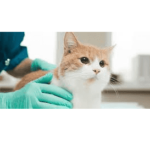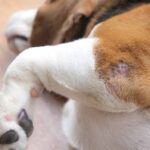An abscess forms when an infected bite wound heals over on the surface, sealing the infection inside. Fever is generated as the infection incubates. Diseased tissue and the inflammatory cells liquefy into pus. The pus breaks through the overlying surface skin and drains, leading to foul odor, pain, and discharge. The area may or may not heal on its own.
What to Look for at Home
A fluid-filled swelling
If the abscess has not yet ruptured, the cat will most likely be feverish, which means you will see listlessness and appetite loss. Depending on how long the area has been swollen, the skin involved may be very tender or fragile. If you look closely, a small scab from the tooth mark that caused the abscess may still be visible on the surface of the swollen area.
A smelly, draining sore
The fluid pocket will eventually rupture and release foul-smelling pus. The fever may break once the rotten tissue is able to drain. You may not see the sore but you probably will smell it.
A wound that is not healing
Some cats will lick the fur away from the wound, making the area more visible. At this point, it is likely to look raw and may no longer be actively draining pus. Sometimes the overlying skin is especially fragile and simply tears away leaving a large raw area.
A tender area
Sometimes the wound is buried in the fur so deeply that it is not apparent. You may only find a tender area and possibly notice the odor characteristic of deep infection.
Common areas for bite wound abscesses include the facial cheeks, the legs, and the base of the tail. These are the areas where fighting cats tend to bite one another.
Treatment
If the abscess has not ruptured, it will need to be lanced. Once the abscess is open, it will need to be flushed clean of infected debris. If the abscess is large or especially painful, sedation may be required to accomplish this.
Older abscesses may have enough devitalized overlying tissue to require surgical trimming and stitches. Some abscesses are large enough to require an indwelling rubber drain to assist with removal of the pus. You may have to flush the drain with disinfectant at home.
The cat will likely need antibiotics at home. If so, you will need to give either pills or liquid medication (tell your veterinarian if you have a preference). Alternatively, there is an injectable antibiotic (Convenia®) that lasts two weeks that may be given in the clinic, eliminating the need for oral medication at home. Your veterinarian will likely recommend one of these treatments in addition to cleaning and flushing out the wound.
Warm compresses are helpful for the first few days following discharge. The heat helps liquefy diseased tissues so that they can drain. To hot pack the area, use a warm (not hot) washcloth applied to the wound for 5 to 10 minutes once or twice a day.



